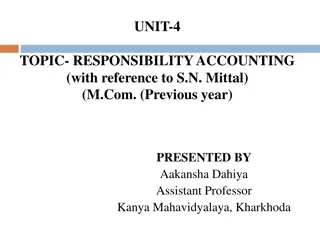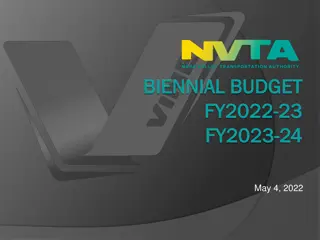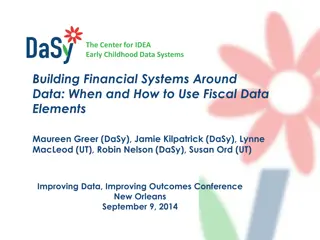Fiscal Responsibility Act & Sustainable Development Nexus
Sustainable development integrates environmental health with economic progress. Achieving SDGs requires fiscal responsibility at all levels of governance. Subnational fiscal irresponsibility impacts national growth. It is crucial to manage public resources effectively to attain sustainable development goals.
Download Presentation

Please find below an Image/Link to download the presentation.
The content on the website is provided AS IS for your information and personal use only. It may not be sold, licensed, or shared on other websites without obtaining consent from the author.If you encounter any issues during the download, it is possible that the publisher has removed the file from their server.
You are allowed to download the files provided on this website for personal or commercial use, subject to the condition that they are used lawfully. All files are the property of their respective owners.
The content on the website is provided AS IS for your information and personal use only. It may not be sold, licensed, or shared on other websites without obtaining consent from the author.
E N D
Presentation Transcript
Sub-nationals and the Fiscal Responsibility Act: Mainstreaming for Sustainable National Development Eze Onyekpere Esq
ARTICULATING SUSTAINABLE DEVELOPMENT The term sustainable development has been articulated as an economic development module that mainstreams environmental and planetary health in a way and manner that does not unduly deplete nature s resources and as such, maintains equilibrium for the survival and flourishing of the Earth and its inhabitants. the dynamic 2
It has been concretised in the 17 Sustainable Development Goals (SDGs) vis; End Poverty Zero Hunger Good Health and Well-Being Quality Education Gender Equality Clean Water and Sanitation 3
Affordable and Clean Energy Decent Work and Economic Growth Industry, Innovation and Infrastructure Reduced Inequalities Sustainable Cities and Communities Responsible Production and Consumption Climate Action Life below Water 4
Life on Land Peace, Justice and Strong Institutions Partnerships for the Goals Essentially, the foregoing are about the proverbial dividends of democracy. The fundamental aphorism is that these SDGs can only be realized when public resources are managed with fiscal responsibility. 5
The Nexus Fiscal Responsibility (FR) and Sustainable Development (SD) meets at the intersection of the policy, plan and budget continuum and reflects in sound and effective public finance management systems. This is the case both at the federal and subnational levels. The imperative of FR at the subnational level is that although we may have 36 states and the FCT, there is only one Nigerian economy. 6
What happens in one state affects the entire Federation and free-riding in terms of refusing to reform while others take the pain of reforms will result in overall inefficiencies and retarded economic growth. It will produce exactly the same kind of situation we have in the Nigeria of today where subnationals find it difficult to meet basic state obligations in essential service delivery and payment of salaries and emoluments of their workers. fiscal irresponsibility, 7
ARTICULATING EFFECTIVE PFM Wikipedia, the Free Online Dictionary defines Public finance as the study of the role of the government in the economy. It is the definitive branch of Economics which assesses the Government revenue and Government expenditure of the Public Authorities and the adjustment of one or the other to achieve desirable effects and avoid undesirable ones. 8
The purview of public finance is considered to be threefold: governmental effects on (1) efficient allocation distribution of income, and (3) macroeconomic stabilization. Resource generation, resource allocation and expenditure management (resource utilization) components of a management system. of resources, (2) are the essential financial public 9
PFM on its own is articulated as the collection of sufficient resources from the economy in an appropriate manner along - allocating and use of these resources efficiently constitute good financial management. Public Finance Management (PFM) basically deals with all aspects of resource mobilization and expenditure management in government. Just as managing finances is a critical function of management in any organization, similarly public finance management is an essential part of the governance process. and effectively 10
Public finance management includes resource mobilization, prioritization of programmes, the budgetary process, efficient management of resources and exercising controls. Rising aspirations of people are placing more demands on financial resources. At the same time, the emphasis of the citizenry is on value for money, thus making public finance management increasingly vital. 11
EFFECTIVE PFM AND FISCAL RESPONSIBILITY The concept of effective PFM is strongly linked to the idea of fiscal responsibility. The word fiscal is generally defined as relating to financial matters, i.e. money and taxes and public revenues belonging to the public treasury. It relates to accounts or the management of revenue and public finances of government. Fiscal policy refers to government s actions with respect to aggregate levels of revenue and expenditure and the resulting surpluses or deficits. It is the primary means by which government influences the economy. 12
The effectiveness will entail a policy, planning and budgeting framework that is inclusive and leaves no one behind, is gender and vulnerability friendly, ensures environmental sustainability, builds institutional capacity for institutional resilience, addition and economic growth, builds local capacity for production and reinforces development as a peoples work in action. promotes value 13
The government sets and implements fiscal policy through a number of means including the budget. Responsibility as a noun is about something which it is your duty to do or look after and for which you take the credit if it goes right and the blame if things go wrong. It is the state of being answerable for an obligation and includes judgement, skill, capacity and ability. 14
Thus a combination of the words fiscal and responsibility to produce fiscal responsibility connotes the responsibility of a government in terms of fiscal issues and policy and how the government is able to pilot fiscal policy based on national and international best practices to the advantage or detriment of its citizens. 15
Fiscal responsibility covers the entire life of fiscal policies and programming, planning and budgeting. It includes sound expenditure conceptualisation within the medium term expenditure framework, the fiscal strategy paper, the revenue and expenditure framework and ensuring that these documentations are done with the best available data. processes from revenue projections, 16
It also includes the process of appropriation approval, the aggregate expenditure ceiling, the information to be sent by the executive to the legislature and the process of public participation at this stage. It reaches out to bring unruly horses of the state economy and their profits and losses within budgetary purview and legislative control. It covers budget execution and reporting, issues of increase or decrease in taxation and personnel expenses. It further includes borrowing, deficits, debts and indebtedness and the duties of oversight over fiscal policy implementation. 17
The concept of fiscal responsibility implies that there is an opposite called fiscal irresponsibility and illustrations of this state of affairs would include inability to collect due taxation, excessive spending in periods of boom and inability to maintain basic services in lean periods, unsustainable indebtedness, de-linking policy, planning and budgeting and generally all such matters that would negatively affect the fiscal wellbeing of the state. 18
Effective PFM is a tool for the realisation of SD, high level government policies, improving the standard of living and translating plans and programmes into actionable frameworks backed by financial and other resources. It involves the notion of fiscal discipline and the ability of government to improve service delivery. 19
Key Points in Effectiveness Credibility and realistic budgeting Comprehensiveness Policy based budgeting Predictability and control Accounting, recording and reporting External scrutiny and audit To achieve the foregoing will need the introduction of key PFM reforms including the: Treasury Single Account 20
Government Management Information System (GIFMIS) International Public Standards (IPSAS) Compliance Integrated Payroll and Personnel Information System ( IPPIS) Limit/Cap Cost to Expenditure Ratio of Government Owned Enterprises, etc. Integrated Financial Sector Accounting 21
Fiscal Discipline Thus in fiscal discipline, we are dealing with balancing the budget, aggregate levels of deficit and surplus Ability to make realistic revenue projections and fund the budget Collecting taxes and keeping taxes at limits that encourage economic growth and job creation Spending according borrowing as much as the capacity to pay back exists. to affordability and 22
Spending according to plan and realising the objectives of expenditure including the SDGs. Keeping the deficit within the 3% of GDP rule. According to section 12 (1) of the FRA: Aggregate expenditure and the aggregate amount appropriated by the National Assembly for each financial year shall not be more than the estimated aggregate revenue plus a deficit, not exceeding three percent of the estimated Gross Domestic Product or any sustainable percentage as may be determined by the National Assembly for each financial year. 23
And by subsection 2 of the same section: (2) aggregate expenditure for a financial year may exceed the ceiling imposed by the provisions of subsection (1) of this section, if in the opinion of the President there is a clear and present threat to national security or sovereignty of the Federal Republic of Nigeria. As amended by the 2020 Finance Act. 24
Proper and scientific determination of the Reference Commodity authorities usually use a moving average for the last five to ten years and in consideration of the outlook of the international community project optimistic, less optimistic and pessimistic scenarios. States are supposed to be consulted in working out the MTEF and determining the RCP. Contrary to received wisdom, states should start a budgeting system that is less dependent on RCP. Price. The federal 25
Saving for rainy day of any amount above the RCP in the Excess Crude Account and Sovereign Wealth Fund. States should also establish their own Stabilisation Account. Essentially, it is about short, medium and long term sustainability of the budgeting and fiscal process. Spending according to revenues and plan and realising the objectives of expenditure. 26
ENHANCING DOMESTIC RESOURCE MOBILISATION (IGR) Subnationals need a strong revenue base in internally generated revenue beyond federal allocations to be sustainable. To qualify to be state properly so called, every state should be able to generate resources to take care of at least its recurrent expenditure in personnel, overheads and debts service. But how is this to be achieved especially in states without a strong industrial base, in mainly rural and poor states? 27
What is the magic that attracts and encourages people to voluntarily pay taxes to government? The first step is transparency and accountability of leadership to the people which concretises a government of the people, by the people and for the people. Every available kobo must be prudently spent and accounted for to the reasonable satisfaction of the ultimate sovereigns, who are the owners of the resources. 28
This builds trust in the citizenry which is needed for development development can collaboration between the leadership and the led. Steps to grow the state economy and position it for effective revenue generation would include: Formalize the informal sector Key reforms in land titling and management because as only happen a 29
Value chain agricultural development through extension and support services Full documentation of the residents Link tax payment to service access Engaging professionals, etc. Link industry and production to research findings You need to grow the economy to derive adequate taxation. 30
DEBT MANAGEMENT S.41 of the FRA is instructive: The framework for debt management during the financial year shall be based on the following rules- (a) Government at all tiers shall only borrow for capital expenditure and human development, provided that such borrowing shall be on concessional terms with low interest rate and with a reasonably long amortization period subject to the approval of the appropriate legislative body where necessary; and 31
(b) Government shall ensure that the level of public debt as a proportion of national income is held at a sustainable level as prescribed by the National Assembly from time to time on the advice of the Minister. It is instructive to state that Borrowing has been defined in the interpretative section of the Act to mean any financial obligation arising from - any loan including principal, interest, fees of such loan; the deferred payment for property, goods or services; 32
bonds, debentures, notes or similar instruments; letters of credit and reimbursement obligations in respect thereto; trade or banker s acceptances; capitalized amount of obligations under leases entered into primarily as a method of raising financing or of financing the acquisition of the asset leased; agreements providing for swaps, ceiling rates, ceiling and floor rates, contingent participation or other hedging mechanisms with respect to the payment of interest or the convertibility of currency 33
and a conditional sale agreement, capital lease or other title retention agreement. Concessionalterms is defined in the interpretative section to mean that the terms of the loan must be at an interest rate not exceeding 3 percent. From available information, with the exception of facilities from international development agencies like the World Bank which do not stricto sensu have interest rates but service charges, no Nigerian bank loan, bond or any other facility can come at 3 percent interest rate. Essentially, this provision bars governments from borrowing from Nigeria banks. 34
Limits on Consolidated Debts Beyond the foregoing, subnational governments are entitled to borrow from the capital market. By section 42 (1) The President shall, within 90 days from the commencement of this Act and with advice from Minister of Finance subject to approval of National Assembly, set overall limits for the amounts of consolidated debt of the Federal, State and Local Governments pursuant to the provisions of items 7 and 50 of Part I of the Second Schedule to the Constitution and the limits and conditions approved by the National Assembly, shall be consistent with the rules set in this Act and with the fiscal policy objectives in the Medium- Term Fiscal Framework. 35
The FRA defines Consolidateddebt as the aggregate of the outstanding financial obligations of Government including those of its parastatals and agencies at any point in time arising from borrowed money including principal, interest, fees of such borrowed money; the deferred payment for property, goods or services; bonds, debentures, notes or similar instruments; letters of credit and reimbursement obligations with respect thereto; Guarantees; Trade or banker s acceptances; 36
Capitalized amounts of obligations under leases entered into primarily as a method of raising financing or of financing the acquisition of the asset leased; agreements providing for swaps, ceiling rates, ceiling and floor rates, contingent participation or other hedging mechanisms with respect to the payment of interest or the convertibility of currency and a conditional sale agreement, capital lease or other title retention agreement. However, the President and NASS are yet to set the consolidated debt ceiling. 37
Specification of Purpose of Borrowing By section 44 of the FRA, (1) Government in the Federation or its agencies and corporations desirous of borrowing shall, specify the purpose for which the borrowing is intended and present a cost-benefit analysis, detailing the economic and social benefits of the purpose to which the intended borrowing is to be applied. Any 38
And by subsection (2); Without prejudice to subsection (1) of this section, each borrowing shall comply with the following conditions- (a) the existence of prior authorization in the Appropriation or other Act or Law for the purpose for which the borrowing is to be utilized; and (b) the proceeds of such borrowing shall solely be applied towards long-term capital expenditures. 39
Cost Benefit Analysis Cost-benefit-analysis is defined in the interpretative section of the FRA to mean an analysis that compares the cost of undertaking a service, project or programme with the benefits that citizens are likely to derive from it. Stating in an Appropriation Bill, which is subsequently passed by the legislature and assented to by the Governor that part of the budget revenue would be sourced from borrowing without specifying which activities and projects the borrowing would be 40
applied to would not satisfy the provisions of the above section. This is because it is a general statement of intent to borrow which does not specify the purpose of borrowing. And because of its general nature, the executive does not submit a cost benefit analysis for the approval of the legislature. During budget approval or after legislative approval of the general deficit financing by borrowing, the executive needs to present specific projects and their respective cost benefit analysis for the approval of the legislature. 41
Essentially, borrowing consonance appropriation powers. Further, the last sub-section, rules out borrowing for recurrent purposes. legislative and approval terms legislative of in its with is 42
Borrowing from Banks By section 45 of the FRA on Lending by financial institutions (1) All banks and financial institutions shall request and obtain proof of compliance with the provisions of this Part before lending to any Government in the Federation. (2) Lending by banks and financial institutions in contravention of this Part shall be unlawful. The DMO Subnational borrowing guidelines state: 43
Section 24 of the DMO Act and the demands of the FRA requires all banks and financial institutions requiring to lend money to the Federal , State and Local Governments or any of their agencies to obtain prior approval of the Minister of Finance. They shall state the purpose of the borrowing and the tenor. The monthly debt service ratio of a subnational which includes the commercial bank loan being contemplated should not exceed 40% of its monthly Federation Account Allocation of the preceding 12 months. 44
Borrowing from the Capital Market This is done under the Investments and Securities Act through Registered Bonds or Promissory Notes. The relevant provisions of the Act include the following: The total amount of loans outstanding at any point in time including the proposed loan shall not exceed 50% of the actual revenue of the body concerned for the preceding 12 months. 45
Any internal loan to be raised from the Capital Market must conform to the requirements of ISA and as may from time to time be directed by the Securities and Exchange Commission (SEC); Before any application is made for contracting a loan from the Capital Market, such a body making the application must obtain the Approved Resolution of the State House of Assembly and the State Executive Council in the case of States and Local Governments; and 46
All applications to raise funds from the Capital Market shall, amongst other documents, be accompanied by an original copy of an irrevocable Letter of Authority giving the Accountant General of the Federation the authority to deduct at source from the statutory allocation due to the body, in the event of default by the body in meeting its payment obligations under the terms of the loan and the relevant Trust Deed. 47
CONCLUSION It is in the overall interest of states to manage their finances and resources sustainably and with discipline. The benefits are legion and include averting a fiscal crisis, ability to meet obligations as at when due, realisation of government policies and improved service delivery, greater accountability and transparency, citizenship confidence in government and an environment for the deepening consolidation of developmental gains. of democracy and 48























